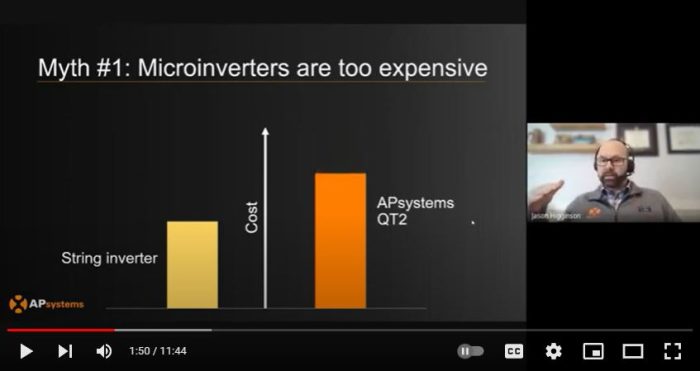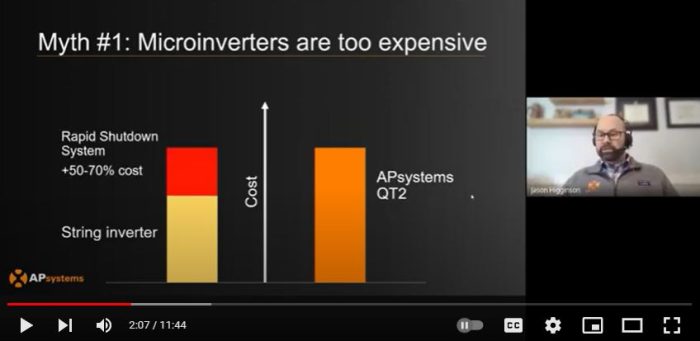
Microinverters have been a hit residential solar for how they simplify installation, provide panel level monitoring and shade mitigation and meet rapid shutdown code requirements. Can next-generation microinverters do the same for commercial solar? Here to make The Pitch is Jason Higginson, head of marketing for APsystems in the U.S.
- 0:33 – Are microinverters cost-competitive enough in C&I solar?
- 2:48 – What system sizes are microinverters cost competitive?
- 3:27 – Will you need to limit module wattage?
- – Details on QT2 specs
- 5:22 – Wiring microinverters into three-phase
- 6:04 – What’s new in setup and commissioning?
- 6:40 – Comparing points of failure
- 7:42 – What about safety / failure compared to string inverters?
- 9:53 – Best strategy for getting started
- 10:44 – What if I don’t have any shading?
Watch the whole episode right here. Below is part of the transcript.
Are microinverters cost competitive in C&I solar?
Chris Crowell: So, Jason, APsystems recently launched the QT2, a robust micro inverter for the C&I space. Before we zoom in on that, I wanted to zoom out more broadly and talk about cost, if we could start there, because that’s often where conversations would end when it comes to microinverters on a large roof.
Jason Higginson: Yeah, yeah, exactly.
Crowell: So have microinverters become more competitive in commercial solar?
Higginson: Short answer: Yes. If we were talking 10 years ago, it would have been an open and shut case … there’s a lot of kind of preconceptions about what microinverters were good for, and so I’ve come on the show today to bust some myths about microinverters in commercial and I’m excited to do that.
… When you look at cost historically, you’ve had string inverters at a very favorable cost for commercial solar. Microinverters came in at twice the price, sometimes more. And that’s where that conversation ended. But what we’ve seen over the last 10 years is the cost for microinverters dramatically have gone down. String inverters as well, but significantly more for microinverters, especially with APsystems where we’ve combined four inverters in one unit — and it doesn’t cost the same as producing four individual inverters.

So, you also add in the cost of a rapid shutdown system since the [addition of] NEC requirement for rapid shutdown. And it comes in at 50 to 70 percent of the inverter cost added on top of it. So, immediately you’re looking at much more competitive pricing with traditional string systems plus rapid shutdown in comparison with microinverters.

They’re coming into one to three percent over under on comparable system pricing, so microinverters have gotten very aggressive when it comes to those commercial applications, and they’re more cost competitive than ever.
Crowell: What system sizes are we talking about? At some point I assume that math tips. What is that pivot point?
Higginson: Well that was our expectation too. We’ve been able to get into commercial solar in the past with with some of our other microinverters. But when you get to the larger system sizing, you get to half a MW to 1 MW, and it’s made more sense to go with another solution. But with the QT2 we were penciling out 1 MW installations, and we were still within that one to three percent of cost.
Pick up the conversation right there ….
— Solar Builder magazine
[source: https://solarbuildermag.com/news/are-microinverters-cost-competitive-in-ci-solar-the-pitch/]
Leave a Reply
You must be logged in to post a comment.